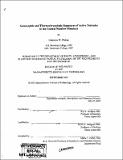Geomorphic and thermochronologic signatures of active tectonics in the central Nepalese Himalaya
Author(s)
Wobus, Cameron W
DownloadFull printable version (17.41Mb)
Other Contributors
Massachusetts Institute of Technology. Dept. of Earth, Atmospheric, and Planetary Sciences.
Advisor
Kip V. Hodges and Kelin X. Whipple.
Terms of use
Metadata
Show full item recordAbstract
The central Nepalese Himalaya are characterized by a sharp transition in physiography that does not correlate with previously mapped faults. Rates of rock uplift, erosion, and exhumation for rocks surrounding this physiographic transition are investigated using digital topographic data, ⁴⁰Ar/³⁹Ar thermochronology, cosmogenic radionuclides, and thermal modeling, to determine whether this break in landscape morphology reflects active tectonic displacements at the foot of the Himalaya. The goals of the thesis are 1) to understand the degree to which landscape morphology can be used to delineate breaks in rock uplift in active orogens; 2) to characterize the neotectonics of central Nepal using data representing varied temporal and spatial scales of inquiry; and 3) to move closer to understanding the dynamic interactions among climate, erosion and tectonics in a field setting. Analysis of digital topographic data from Nepal and other tectonically active settings demonstrates how breaks in the simple scaling characterizing river systems can be used to identify tectonic boundaries. (cont.) Limitations to these methods are illustrated by way of an example from the Eastern Central Range of Taiwan, but changes in landscape morphology become the foundation upon which further investigations are built for central Nepal. These investigations include data from detrital ⁴⁰Ar/³⁹Ar thermochronology to characterize changes in exhumation rates at million-year timescales; cosmogenic ¹⁰Be to characterize changes in erosion rates at millennial timescales; and simple thermal modeling to evaluate a range of alternative tectonic geometries for central Nepal. The data point to the existence of a tectonically significant, thrust- sense shear zone at the base of the high Himalaya in central Nepal, nearly 100 km north of the active thrust front. The existence of this fault zone in a location where the Indian summer monsoon is concentrated is consistent with the predictions of numerical and analytical models of orogenic growth, which suggest a direct feedback between focused erosion and tectonic displacements in active orogens. (cont.) Future work is warranted to evaluate the persistence of climatic and tectonic signals over a variety of time and space scales in central Nepal, and to determine whether correlations between climate and tectonics exist in other field settings.
Description
Thesis (Ph. D.)--Massachusetts Institute of Technology, Dept. of Earth, Atmospheric, and Planetary Sciences, 2005. Includes bibliographical references.
Date issued
2005Department
Massachusetts Institute of Technology. Department of Earth, Atmospheric, and Planetary SciencesPublisher
Massachusetts Institute of Technology
Keywords
Earth, Atmospheric, and Planetary Sciences.